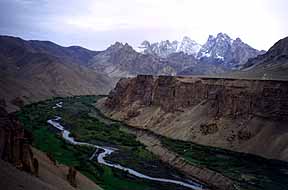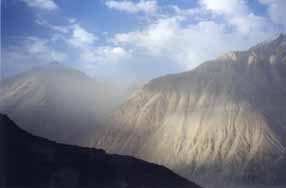Case Study
Traditional Agriculture in Ladakh
 |
|
|
CONTENTS
Back to Agroecosystems Home Page
Back to Traditional Agriculture page
Prepared by Luc Kazimirski
All photographs by the author.
OVERVIEW
There is very little litterature available on Ladakh. Most of the information presented in this page was gathered on a recent trip to the area. In the summer of 1998, I spent six weeks in Ladakh exploring, talking to local people, treking and observing. It is an area of intense natural beauty; surrounded by some of the highest mountains in the world, richly colored rock, bright green irrigated valleys and huge smiling faces.
This page focuses on the agriculture of Ladakh and the unique adaptations that have been made there to allow the people to survive in this high altitude desert. Despite the short growing season, absence of rainfall, and harsh climate, Ladakhi people produce more than enough food for themselves. This is achieved through a complex network of irrigation canals and an interresting method of developing and fertilizing soils. This is an excellent example of how traditional farmers can be creative and adaptive (see Richards, 1986).
The agriculture of Ladakh also illustrates some of the common characteristics of traditional farming described on the previous page. Ladakhi farmers use low levels of inputs, maintain diversity of production systems and actually promote trophic complexity much greater than the surrounding natural systems.
KEY FACTS
(Bhasin, 1992)
- Average annual rainfall, 10 cm/year
- Area, 59,000 km2
- Average elevation, 3450 m
- Highest mountain pass, Kardung La 5800 m
- Population, 140,000 people
- Population density, 2 people / km2 (one of the lowest in the world)
- Temperature range, -40°c (winter) to 30°c (summer).
GEOGRAPHY
 |
|
From Norberg-Hodge Ancient Futures, 1991 |
Ladakh is situated on the high Tibetan plateau. To the South lies India and the Himalayan mountain range, to the north is the Karikoram mountain range to the west is Indian Kashmir and to the east lies Tibet.
It is in the rain shadow of the Himalayas making it one of the driest places on earth. Very little grows naturally in this harsh environment, though a few small succulent plants, some grasses and moss manage to survive. In damp soils near rivers willows survive and are an important source of building materials. Wild animals are also rare. Those that are present tend to be well adapted to harsh environment and few in number. There are Yaks, snow leopards, blue sheep, Ovis amon (the Great Tibetan sheep), Himalayan marmot, coyotes, wolves, lynx, musk deer and even wild camels in the isolated Nubra Valley. The people in Ladakh are quite ethnically diverse. Western Ladakh is mainly Muslim, there are pockets of Arian peoples who migrated from Western Asia almost a thousand years ago, but the majority are Indo-Tibetan Buddhists.
ECOLOGY
Ladakh is a truly self-sufficient culture. The first road into the area was built only 20 years ago. Therefore almost everything was produced locally by necessity. It is for this reason that Ladakh is of importance from an agroecological perspective. The traditional farming techniques of the region are still in use. One does not have to search for someone who knew how things used to be done; people everywhere still use the same farming methods that have been used for centuries. These unique methods, having co-evolved with the culture, have allowed the Ladakhis to survive in what seems to most people to be a completely inhospitable climate.
 |
|
canal that supplies the water |
Animals are also an important component of Ladakhi subsistence. They raise sheep, goats, horses and their revered dzo, a cross between a yak and a cow. This is their most important draft animal as well as their primary source of milk, cheese and wool. In Ladakh, the higher altitude pastures are actually more productive. They therefore appoint one or two members of the village to take all the animals to high pasture. While there, the animals graze and the attendants spin wool, make butter and cheese and collect dung for the winter. This system diversity ensures relatively constant food production from season to season and from year to year. Fresh vegetables ripen in the summer, apples and barley are ready in the fall and animals produce fresh dairy all year. Additionally, livestock are insurance for extremely harsh growing seasons. They can be eaten if the crops do not produce enough in any given season.
Ladakhi farmers produce nearly all the necessary inputs on farm. Human and animal wastes are mixed with inedible crop residues. After composting, this rich organic matter is applied to the fields. As previously mentioned, the soils are also enriched with a great deal of minerals and nutrients from flooding. These techniques ensure the farmers are highly self-sufficient and are not dependent on external inputs.
The surrounding ecosystems support very low species diversity. Ladakh is a high altitude desert where virtually nothing grows. The farming systems in Ladakh actually increase the trophic complexity of the ecosystem. The pictures on this page show how lush and green the irrigated valleys can be. Without the involvement of the farmers, these valleys would be as barren as the surrounding desert. Traditional farmers in the Trokkkpics maintain trophic complexity approaching natural systems. Ladakhi farmers actually surpass the trophic complexity of the surrounding ecosystems.
 |
|
|
USEFUL LINKS
- ABOUT LADAKH,
INDIA
(http://www.ecovillages.org/india/ladakh/ladakh.html) International Society for Ecology and Culture, Spons. (1999, January 19; Viewed 5 Feb. 2001)
- THE
HIMALAYAS-LADAKH HIMALAYAS
(http://tqd.advanced.org/10131/ladakh.html) ThinkQuest Team, Spons. (1997, August 1; Viewed 5 Feb. 2001)
- LADAKH
(http://www.pugmarks.com/d-india/ladakh.htm) Discover India Travel Magazine, Spons. (1996, August 12; Viewed 5 Feb. 2001)
- MONASTERIES
GROWING HIMALAYAN HERBS SAVED FROM
EXTINCTION
(http://www.globalideasbank.org/crespec/CS-105.HTML) Jen van der Waals, Auth. (1996, January 19; Viewed 5 Feb. 2001)
CITED LITERATURE
- Alteri, M. 1987. Agroecology, The Scientific Basis of Alternative Agriculture. Westview Press, Boulder, Colorado.
- Bhasin, M. 1992. Cold Desert: Ladakh, Ecology and Development. Kamla-Raj Enterprises, Delhi.
- Norberg-Hodge, H. 1997. A radical challenge to the encroachment of monoculture. Development 40: 67-70.
- Norberg-Hodge, H. 1991. Ancient Futures, Learning from Ladakh. Sierra Club Books, San Francisco.
- Richards, P. 1985. Indigenous Agriculture Revolution: Ecology and Food production in West Africa. Westview Press, Boulder, Colorado.